French school; first half of the XVII century."The Judgement of Jesus in the Sanhedrin".Oil on canvas. Re-drawn.
Lot 85
About Seller
Setdart Auction House
Carrer Aragó 346
Barcelona
Spain
Setdart Subastas was born in 2004 and is currently the first online art auction in Spain with solidity, prestige and reliability guaranteed by our more than 60,000 users. Setdart has a young, dynamic and enterprising team ready to successfully manage the purchase and sale of art works through custom...Read more
Estimate:
EUR€32,000 - EUR€35,000
$34,408.60 - $37,634.41
Absentee vs Live bid
Two ways to bid:
- Leave a max absentee bid and the platform will bid on your behalf up to your maximum bid during the live auction.
- Bid live during the auction and your bids will be submitted real-time to the auctioneer.
Bid Increments
| Price | Bid Increment |
|---|---|
| EUR€0 | EUR€10 |
| EUR€200 | EUR€25 |
| EUR€500 | EUR€50 |
| EUR€1,000 | EUR€100 |
| EUR€3,000 | EUR€200 |
| EUR€5,000 | EUR€500 |
| EUR€10,000 | EUR€1,000 |
| EUR€20,000 | EUR€2,000 |
| EUR€50,000 | EUR€5,000 |
About Auction
By Setdart Auction House
Jul 14, 2021
Set Reminder
2021-07-14 06:30:00
2021-07-14 06:30:00
America/New_York
Bidsquare
Bidsquare : OLD MASTERS
https://www.bidsquare.com/auctions/setdart-auction-house/old-masters-7202
Setdart Auction House sofia@setdart.com
Setdart Auction House sofia@setdart.com
- Lot Description
French school; first half of the XVII century. "The Judgement of Jesus in the Sanhedrin". Oil on canvas. Re-drawn. Presents a legend in French. It has repainting and period frame. Size: 85 x 151 cm; 97 x 163 cm (frame). The work, representing the Ecce Homo belongs biblically speaking to the cycle of the Passion, and precedes the episode of the Crucifixion. Following this iconography, Jesus is presented at the moment when the soldiers mock him, after crowning him with thorns, dressing him in a purple tunic (here of violet color, also symbolic color of the Passion) and placing a reed in his hand, kneeling and exclaiming "Hail, King of the Jews!". The words "Ecce Homo" are those pronounced by Pilate when presenting Christ before the crowd; their translation is "behold the man", a phrase by which he mocks Jesus and implies that Christ's power was not such in front of that of the leaders who were judging him there. In this work in particular, the figure of Christ as Ecce Homo is displaced from the center of the composition. He is placed on the right side, seated, in profile to the viewer and with his head tilted downwards. In the center, however, standing upright, is the figure of a pontiff, framed in a kind of cloth band, and opening his hands towards the faithful. This figure is accompanied by a cartouche, with a barely legible text. The scene has a multitude of characters, who congregate around these figures, who also have a cartouche that identifies them. It is possible that the scene narrates the moment in which Jesus is presented before Herod, being this the enthroned figure, seated in the left zone of the composition. The episode is narrated in the Gospel of Luke: after being judged by the Sanhedrin, Jesus is sent to the Roman governor Pontius Pilate, who upon learning that he was a Galilean understood that the case would be under the jurisdiction of Herod Antipas.
- Shipping Info
-
In-house shipping available. Please inquire at admin@setdart.com.
-
- Buyer's Premium



 EUR
EUR CAD
CAD AUD
AUD GBP
GBP MXN
MXN HKD
HKD CNY
CNY MYR
MYR SEK
SEK SGD
SGD CHF
CHF THB
THB



















